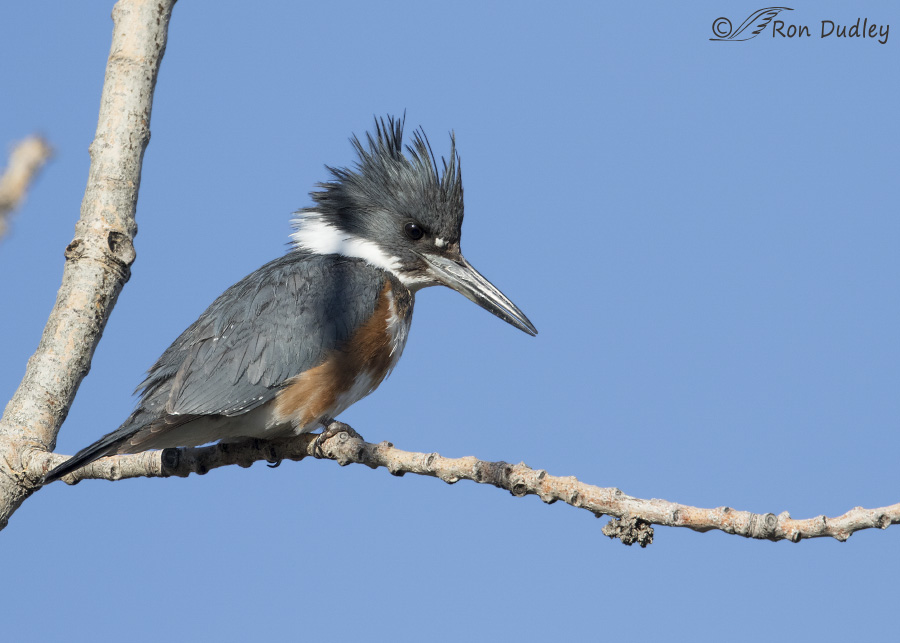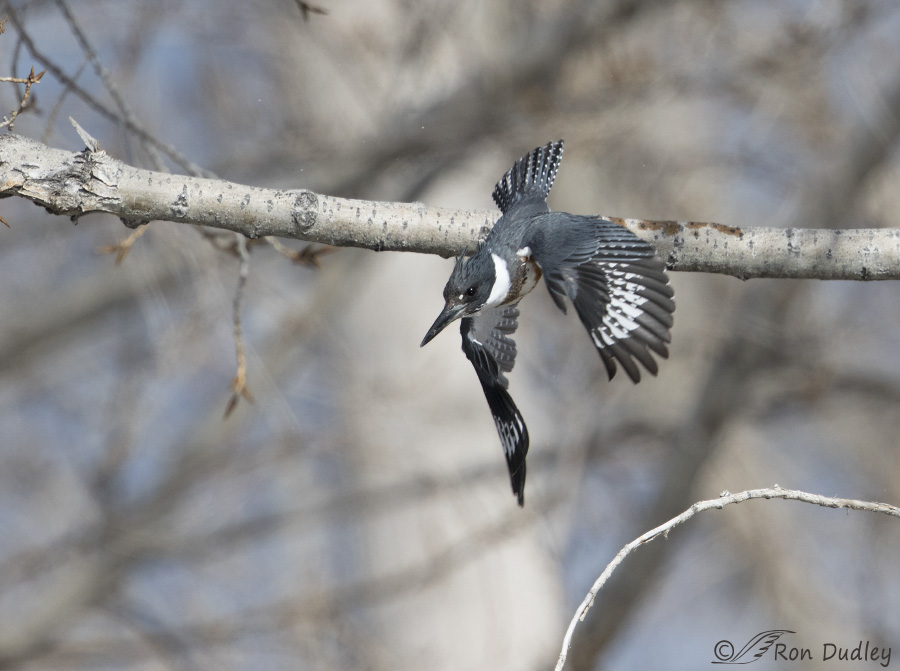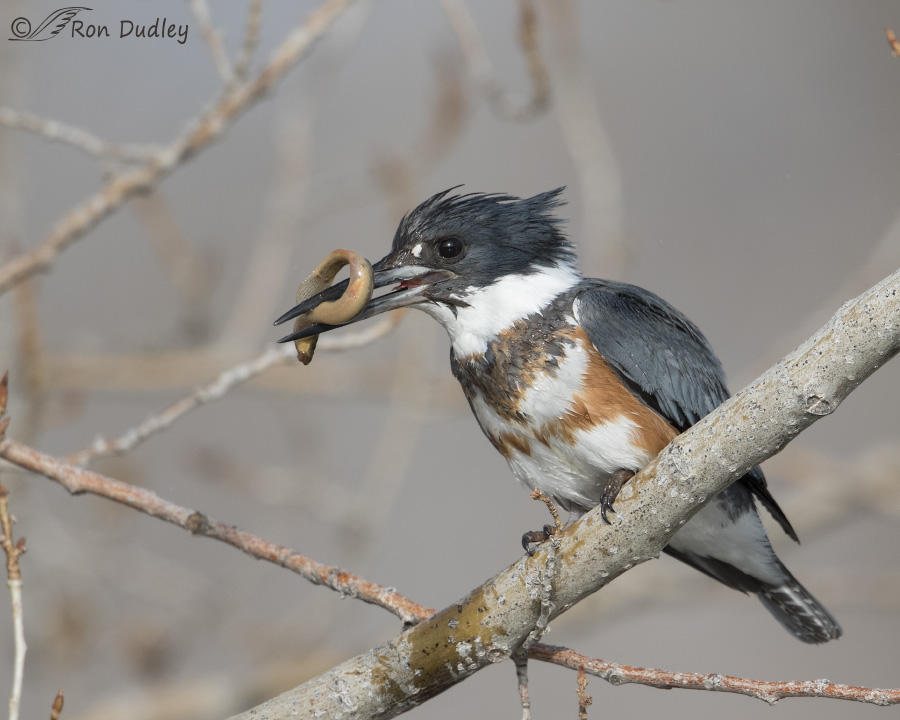Belted Kingfishers have always been one my most difficult avian subjects because they’re so very difficult to approach. But last February I spent several afternoons with this adult female at a local pond and she was actually cooperative at times.
I’ve posted images of this bird in the past but these three are new to my blog.

1/2500, f/6.3, ISO 500, Canon 7D Mark II, Canon EF 500mm f/4L IS II USM + 1.4 tc, not baited, set up or called in
Here she’s scanning the pond below her for fish. I’m not fond of the vertical shadow on her body but for me it’s not an image-killer because her face and bill are well-lit and I was close enough to get good detail. When she was watching for fish her concentration on the pond was about as intense as it can get.

1/3200, f/6.3, ISO 500, Canon 7D Mark II, Canon EF 500mm f/4L IS II USM + 1.4 tc, not baited, set up or called in
While I was with her it was always one of my goals to catch her at takeoff as she dove on a fish but when I was close to her she was always too quick for me. I came close a few times but something always went wrong (usually clipped body parts). So I tried it from further away and got this shot where she’s small in the frame but I do like her flight posture. This time she missed the fish but…

1/1600, f/7.1, ISO 500, Canon 7D Mark II, Canon EF 500mm f/4L IS II USM + 1.4 tc, not baited, set up or called in
she was successful several times while I was with her. Here she’s caught an invasive weather loach. The wet spot on the perch is where she was slamming it against the branch to stun it before she gobbled it down.
In the months since these photos were taken I’ve found this bird at the same pond several times but now that the leaves are out she’s always been mostly hidden so I’m glad I had this time with her when I did.
Ron
Note: As of last night the Antelope Island wildfire was 80% contained but 14,560 acres of the 28,000+ acre island have been burned. For now only the north part of the island is open to the public.


Ron, thanks for capturing her fishing expedition and sharing the details with me, we’ll all of us lurchers. Great shots. So wonderful to see. Diana
The intensity of her gaze in the first photo draws me into her head so closely,trying to understand her perceptions, that I didn’t even notice the shadow. That predatory stare is the same across reptiles, birds and mammals. I’m not certain about fish and amphibians because I haven’t watched them hunt often. I never noticed my pet American toads eyes getting that glassy but focused staring look when I fed them mealworms but it might have passed too quickly for me to notice before they were wiping their front digits across their face, messing it up with dirt, swallowing and smiling. They were a bit amusing to me when eating; so, their actions made me happy to feed them and spend my allowance on mealworms. I haven’t watched salamanders hunt. My anoles got that stare when hunting.
I love the second photo because it’s similar to what I see when I get a great perch hunting view using 8X binoculars. Seeing the white spots when I do manage to get that good a view before they dive is so special and has always happened along creeks.
I think the little green kingfishers in south TX were easier to approach more closely than the Belted Kingfishers in the 1980s. I have no idea what that’s like now with more birding and butterflying activity near McAllen/Mission.
Pam, I kept a salamander in my classroom when I was teaching. They’re very patient while approaching prey and faster than one might think when they need to be. Pretty interesting to watch the feeding process.
Feathered enchantment.
And of course her concentration was intense. Survival can do that.
I am so glad that the fire is out. And my heart aches for the losses.
I was able to visit part of the island this morning, EC. Much of it just looks black. Depressing…
Great take off picture! Can almost picture that loopy, swoopy flight and imagine the sound of rushing water and trembling Aspen leaves …..
Thank you, Patty.
I too like the white spots on their feathering that are not noticed unless they are flying. I wonder what they look like to other birds since they see in other light spectrums than us humans.
Yes the fire is out. Antelope Island face book page posted a few photos of damaged areas I compared them to my photos this spring of the same area. Sad indeed. However it looks like mostly cheat grass and dry grass burned The sage and larger plants still look green. Perhaps the heat did not damage them. Time will tell.
April, the sage is one of the things I really want to check on when we can get to that part of the island. They told me this morning that they’re hoping to open the road to the ranch tomorrow but all trails are and will remain closed, at least for a while.
Was the Kingfisher down there on the Jordan Parkway trail by the golf course perhaps? I’ve seen one down there and was completely fascinated
Yes, that’s where she was. I’ve seen her in that general area many times but I haven’t spotted her for about 6 weeks now.
I love being able to look at these birds so closely! What beauties they are.
I agree, Carol – they’re not only beautiful but they’re also quite unique.
Awesome! Great photos. I am so glad you shared. They are so hard to get close too. I spotted a female on a telephone wire across from a local watershed. I was able to pull off the road and take pics but they are from below and I have no bragging rights other than she didn’t fly away.
Cheryl, just the fact that she didn’t spook on you gives you at least some bragging rights – that doesn’t happen every day with this species.
What I loved about the second shot is that it so clearly illustrates the marking patterns on all parts of the open wings and the fanned tail feathers –just gorgeous !
Good observation, Kris. Thank you.
Beautiful! – they are a challenge and the 2nd photo it REALLY nice! Glad the fire is getting contained, but that’s a lot of ground lost for habitat. 🙁
I visited part of the island this morning, Judy. It was my “grieving trip”.
Great shots Ron!
I have to agree with hanging the flying picture next to the Magpie!
I just wish the bird was a little larger in the frame in that image, Dick.
You have good cropping software don’t you?
If that doesn’t work either of the other two are great in book!!
Dick, I’m afraid that image has already been heavily cropped as presented.
Nice. Seems like they simply like to taunt you with their call. Have one on the pond at the Alder Montana rv park that calls you out only to disappear as you try to approach.
Yup, they’re champion taunters, Frank. And they do it vocally which only makes it worse!
I love those!!!!!!!!! That flying kingfisher should go on your wall right next to your magpie!!!!!!!
I’m glad you remember that magpie print, Marina. Obviously, it’s one of my favorites.
Spectacular series Ron! Thanks for sharing!
Charlotte
Thank you, Charlotte.
Again, just Oh WOW! I fell in love with a belted Kingfisher in Dallas. She fished a little creek that fed through White Rock Lake park and I stopped to watch her regularly just because. They’re just so beautiful.
Wanting the fire to be OUT, NOW!
Laura, I think many of us remember our encounters with kingfishers more than we might some other birds. Especially if we’re close!
I really like all of these shots, but especially the first one. The shadow on it doesn’t bother me, because what stands out is that this portrait captures the beauty of the bird like no other photos I’ve ever seen of a Kingfisher.
Thanks very much, Susan. I’m glad you like it.
Hi Ron
Nice shots of the Kingfisher. You must know the bird behavior really well to time the take offs so well.
Thanks for the great blog.
Thanks, Nikhil. I watch behaviors very carefully but there’s also a bit of luck involved. They take off very quickly.